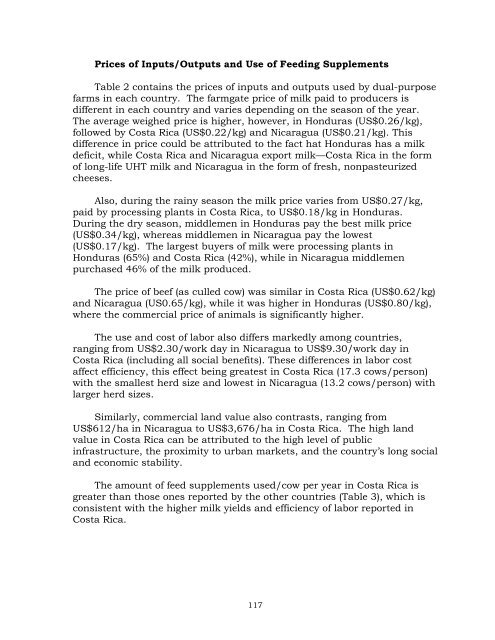Feeding Systems with Legumes to Intensify Dairy Farms - cgiar
Feeding Systems with Legumes to Intensify Dairy Farms - cgiar
Feeding Systems with Legumes to Intensify Dairy Farms - cgiar
Create successful ePaper yourself
Turn your PDF publications into a flip-book with our unique Google optimized e-Paper software.
Prices of Inputs/Outputs and Use of <strong>Feeding</strong> Supplements<br />
Table 2 contains the prices of inputs and outputs used by dual-purpose<br />
farms in each country. The farmgate price of milk paid <strong>to</strong> producers is<br />
different in each country and varies depending on the season of the year.<br />
The average weighed price is higher, however, in Honduras (US$0.26/kg),<br />
followed by Costa Rica (US$0.22/kg) and Nicaragua (US$0.21/kg). This<br />
difference in price could be attributed <strong>to</strong> the fact hat Honduras has a milk<br />
deficit, while Costa Rica and Nicaragua export milk—Costa Rica in the form<br />
of long-life UHT milk and Nicaragua in the form of fresh, nonpasteurized<br />
cheeses.<br />
Also, during the rainy season the milk price varies from US$0.27/kg,<br />
paid by processing plants in Costa Rica, <strong>to</strong> US$0.18/kg in Honduras.<br />
During the dry season, middlemen in Honduras pay the best milk price<br />
(US$0.34/kg), whereas middlemen in Nicaragua pay the lowest<br />
(US$0.17/kg). The largest buyers of milk were processing plants in<br />
Honduras (65%) and Costa Rica (42%), while in Nicaragua middlemen<br />
purchased 46% of the milk produced.<br />
The price of beef (as culled cow) was similar in Costa Rica (US$0.62/kg)<br />
and Nicaragua (US0.65/kg), while it was higher in Honduras (US$0.80/kg),<br />
where the commercial price of animals is significantly higher.<br />
The use and cost of labor also differs markedly among countries,<br />
ranging from US$2.30/work day in Nicaragua <strong>to</strong> US$9.30/work day in<br />
Costa Rica (including all social benefits). These differences in labor cost<br />
affect efficiency, this effect being greatest in Costa Rica (17.3 cows/person)<br />
<strong>with</strong> the smallest herd size and lowest in Nicaragua (13.2 cows/person) <strong>with</strong><br />
larger herd sizes.<br />
Similarly, commercial land value also contrasts, ranging from<br />
US$612/ha in Nicaragua <strong>to</strong> US$3,676/ha in Costa Rica. The high land<br />
value in Costa Rica can be attributed <strong>to</strong> the high level of public<br />
infrastructure, the proximity <strong>to</strong> urban markets, and the country’s long social<br />
and economic stability.<br />
The amount of feed supplements used/cow per year in Costa Rica is<br />
greater than those ones reported by the other countries (Table 3), which is<br />
consistent <strong>with</strong> the higher milk yields and efficiency of labor reported in<br />
Costa Rica.<br />
117
















